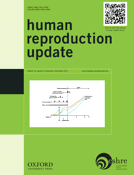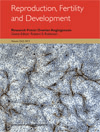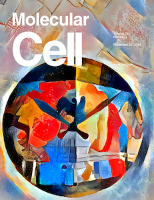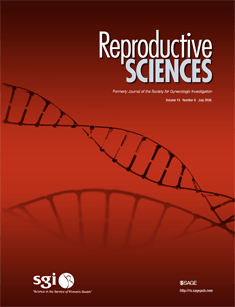
MOLECULAR REPRODUCTION AND DEVELOPMENT
Scope & Guideline
Connecting researchers to advance the science of reproduction.
Introduction
Aims and Scopes
- Molecular Mechanisms of Reproduction:
Research in this area investigates the molecular and cellular processes involved in gametogenesis, fertilization, and early embryonic development. This includes studies on gene expression, signaling pathways, and the roles of specific proteins and RNAs. - Comparative Reproductive Biology:
The journal emphasizes comparative studies across different species, providing insights into the evolutionary aspects of reproduction and development. This includes examining reproductive strategies, gamete interactions, and embryonic development in various taxa. - Impact of Environmental Factors on Reproductive Health:
Research addressing how environmental factors, such as endocrine disruptors, temperature, and nutrition, affect reproductive outcomes and developmental processes is a significant focus. This includes studies on how these factors influence gene expression and reproductive physiology. - Innovative Reproductive Technologies:
The journal publishes studies on advanced reproductive technologies, including assisted reproductive techniques, genetic editing, and novel methodologies for embryo culture and assessment. This encompasses both animal models and human applications. - Pathophysiology of Reproductive Disorders:
Research into the mechanisms underlying reproductive disorders, such as polycystic ovary syndrome, infertility, and developmental defects, is central to the journal. This includes exploring genetic, epigenetic, and environmental contributions to these conditions.
Trending and Emerging
- Role of Extracellular Vesicles in Reproduction:
Research on extracellular vesicles, particularly their roles in communication during fertilization and early embryo development, is gaining traction. These studies highlight the importance of intercellular signaling in reproductive processes. - Epigenetic Regulation in Reproductive Health:
An increasing number of studies are investigating epigenetic modifications and their impact on reproductive outcomes. This includes exploring how environmental factors influence epigenetic changes in gametes and embryos. - Application of Advanced Imaging Techniques:
The use of novel imaging technologies, such as time-lapse imaging and optical coherence tomography, is trending. These techniques facilitate real-time observation of gametes and embryos, enhancing our understanding of developmental dynamics. - Integrative Omics Approaches:
Emerging research increasingly utilizes multi-omics approaches (genomics, transcriptomics, proteomics) to provide comprehensive insights into reproductive biology. This trend reflects a move towards understanding complex biological systems in a holistic manner. - Impact of Microbiome on Reproductive Health:
Investigation into the role of microbiota in reproductive health is on the rise. Studies are beginning to explore how microbial communities affect fertility and pregnancy outcomes, indicating a growing interest in the intersection of reproductive health and microbiology.
Declining or Waning
- Traditional Embryology Techniques:
There has been a noticeable decrease in studies focusing solely on traditional embryology methods without integrating molecular insights. As the field moves towards more molecular and genomic approaches, papers emphasizing classical techniques seem to be diminishing. - Species-Specific Studies:
Research focusing exclusively on single species without comparative analysis appears to be less frequent. The trend is shifting towards more integrative studies that compare reproductive mechanisms across multiple species, reflecting a broader interest in evolutionary biology. - Basic Descriptive Studies of Gametes:
While foundational studies on gamete structure and function remain important, there is a waning interest in purely descriptive work without molecular or mechanistic insights. The field is increasingly favoring research that connects basic observations to functional implications.
Similar Journals

Plant Reproduction
Fostering Collaboration in Plant Science ResearchPlant Reproduction is an esteemed academic journal published by Springer, dedicated to advancing the understanding of reproductive processes in plants. With its ISSN 2194-7953 and E-ISSN 2194-7961, this journal serves as a vital resource for researchers and professionals in the fields of cell biology and plant science. Since its inception in 2013, it has been recognized in the Q1 Quartile for plant science, underscoring its significance and impact within the academic community, while maintaining a ranking of #79/516 in the Scopus database for agricultural and biological sciences. The journal embraces an Open Access model, enhancing accessibility for a broader audience of scholars and practitioners. As we continue to converge our research efforts towards 2024 and beyond, Plant Reproduction remains committed to exploring innovative findings and fostering collaboration in plant reproductive biology, thereby contributing significantly to the global understanding of plant systems and their ecological impacts.

JOURNAL OF PLANT BIOLOGY
Connecting Research and Ecology in Plant ScienceJOURNAL OF PLANT BIOLOGY, published by SPRINGER HEIDELBERG, is a leading academic journal dedicated to advancing the field of plant science. With an impressive impact factor signifying its high citation rate and rigorous peer-review process, this journal ranks in the Q1 category within Plant Science, placing it among the top-tier periodicals in the discipline. Established in 1999, it has become an essential resource for researchers, professionals, and students seeking the latest findings and developments in plant biology. The journal fosters a collaborative environment for sharing innovative research, exploring ecological interactions, and understanding plant physiology, thereby contributing significantly to advancements in sustainable agriculture and environmental conservation. Its high Scopus ranking of 102 out of 516 in the category of Agricultural and Biological Sciences further underscores its relevance and impact within the scientific community. For those interested in cutting-edge research, JOURNAL OF PLANT BIOLOGY is a vital source of knowledge, offering insights that are crucial for the future of plant science.

DEVELOPMENT GROWTH & DIFFERENTIATION
Illuminating the Pathways of Growth and DifferentiationDEVELOPMENT GROWTH & DIFFERENTIATION, published by Wiley, stands as a vital journal in the realms of Cell Biology, Developmental Biology, and Medicine. With an ISSN of 0012-1592 and E-ISSN of 1440-169X, this esteemed journal has been a key player in the scientific community since its inception in 1969, continuing to contribute significantly to the understanding of developmental processes and mechanisms underlying growth and differentiation. Ranked Q3 in Cell Biology and Developmental Biology, and Q2 in miscellaneous aspects of Medicine as of 2023, the journal provides a platform for high-quality research articles, reviews, and critical insights that foster academic discourse in these vital fields. Although currently not available as open access, the journal ensures the availability of essential research to its global readership, facilitating collaboration and innovation. Researchers, professionals, and students alike will find DEVELOPMENT GROWTH & DIFFERENTIATION to be an invaluable resource for advancing knowledge and driving forward the scientific inquiry into the intricacies of biological development.

HUMAN REPRODUCTION UPDATE
Pioneering Discoveries in Reproductive HealthHUMAN REPRODUCTION UPDATE, published by Oxford University Press, stands as a leading journal in the fields of Obstetrics and Gynecology and Reproductive Medicine. With an impressive Q1 ranking in both categories according to the 2023 category quartiles and a significant Scopus rank, it is recognized as one of the top journals globally in these disciplines, catering to the most relevant and cutting-edge research. The journal has been a crucial platform for disseminating vital findings and reviews from 1995 to 2024, contributing to advancements in human reproductive health. With its focus on publishing high-quality, peer-reviewed articles, it serves as an essential resource for researchers, healthcare professionals, and students seeking the latest insights and developments in reproductive science. As the journal aims to foster informed discussions and encourage further research, it remains committed to shaping the future of reproductive health and medicine.

REPRODUCTION FERTILITY AND DEVELOPMENT
Exploring the frontiers of fertility and developmental research.Reproduction, Fertility and Development, published by CSIRO Publishing, is a prestigious journal that has been at the forefront of research in the fields of reproductive science, developmental biology, and related disciplines since its inception in 1989. With an ISSN of 1031-3613 and an E-ISSN of 1448-5990, this journal serves as a vital platform for disseminating innovative findings and methodologies that advance our understanding of reproductive processes and development in a variety of organisms. The journal is indexed in prominent databases, exhibiting a solid standing with a Q3 quartile ranking in both Animal Science and Zoology and Biotechnology, and covering 2023 rankings in multiple related categories. Operating from Australia, Reproduction, Fertility and Development embraces a commitment to enriching scholarly communication and fostering collaborative research efforts. Its focus on high-quality, peer-reviewed articles makes it an essential resource for researchers, professionals, and students seeking to stay abreast of the latest advancements and pivotal discussions in reproductive medicine and developmental biology.

Reproductive and Developmental Medicine
Advancing reproductive health and developmental science.Reproductive and Developmental Medicine is a pioneering open-access journal dedicated to advancing knowledge in the fields of reproductive medicine and developmental biology. Published by LIPPINCOTT WILLIAMS & WILKINS, the journal serves as a platform for researchers, clinicians, and graduate students alike, fostering collaboration and dissemination of innovative research findings. With an ISSN of 2096-2924 and E-ISSN 2589-8728, it has established a significant presence in the academic community since its inception in 2017. The journal is indexed in Scopus and achieved a category quartile ranking of Q3 in Obstetrics and Gynecology and Q4 in Reproductive Medicine as of 2023, highlighting its importance as a resource for cutting-edge studies and reviews in these vital areas. The journal's open-access model ensures that research is readily available to scholars and practitioners worldwide, thus enhancing the global discourse in reproductive health and development. This makes Reproductive and Developmental Medicine an invaluable resource for those dedicated to improving outcomes in obstetrics, gynecology, and reproductive health.

Reproductive Medicine and Biology
Unveiling the complexities of reproductive biology.Reproductive Medicine and Biology, an esteemed journal published by WILEY, stands at the forefront of advancements in the field of reproductive health and associated biological sciences. With an impact factor that underscores its relevance—ranking in Q1 for Reproductive Medicine and Q3 in Cell Biology—this journal is distinguished by its commitment to disseminating high-quality, peer-reviewed research since its transition to Open Access in 2002. Based in Japan, the journal caters to a global audience, providing vital insights into reproductive biology, therapeutics, and innovative practices. With Scopus rankings placing it at #22 out of 90 in Reproductive Medicine and a commendable percentile ranking, Reproductive Medicine and Biology aims to foster dialogue and knowledge transfer among researchers, professionals, and students, paving the way for breakthroughs in understanding reproductive health.

Molecular Cell
Your Gateway to Cutting-Edge Biological Discoveries.Molecular Cell, published by Cell Press, is a leading journal in the fields of cell biology and molecular biology. Established in 1997, this prestigious journal boasts a significant impact within the scientific community, evidenced by its impressive 2023 Scopus rankings, placing it in the top 2% of its field (Rank #10/410 in Molecular Biology, Rank #12/285 in Cell Biology). With a focus on cutting-edge research that bridges the gap between molecular genetics and cellular function, Molecular Cell serves as an essential platform for the dissemination of vital findings and innovative methodologies. Although it follows a traditional publishing model without Open Access options, its rigorous peer-review process and high standards ensure that articles published within these pages are of the utmost quality, making it an invaluable resource for researchers, professionals, and students alike seeking to stay at the forefront of scientific discovery. The journal's address is 50 Hampshire St, Floor 5, Cambridge, MA 02139, United States, reinforcing its commitment to fostering scientific excellence and collaboration.

JOURNAL OF MOLECULAR ENDOCRINOLOGY
Advancing the Frontiers of Hormonal ScienceJOURNAL OF MOLECULAR ENDOCRINOLOGY, published by BIOSCIENTIFICA LTD, is a prestigious academic journal that has made significant contributions to the fields of endocrinology and molecular biology since its inception in 1988. With an impressive impact factor that places it in the Q1 category for Endocrinology and Q2 for Molecular Biology, this journal is recognized for its rigorous peer-reviewed research that addresses key questions at the intersection of molecular mechanisms and hormonal regulation. The journal's accessibility within the Scopus rankings, notably positioned 45th out of 128 in Endocrinology, highlights its relevance and influence in shaping contemporary scientific discourse. Although the journal does not currently offer open access options, it remains an essential resource for researchers, professionals, and students eager to explore groundbreaking discoveries and advancements in the hormonal sciences. The JOURNAL OF MOLECULAR ENDOCRINOLOGY continues to pave the way for critical exploration and innovation, ensuring its place as a vital publication for the advancement of knowledge in molecular endocrinology.

Reproductive Sciences
Pioneering Research for a Healthier FutureReproductive Sciences is a premier journal published by SPRINGER HEIDELBERG, dedicated to the field of obstetrics and gynecology. With its ISSN 1933-7191 and E-ISSN 1933-7205, the journal has established itself as a leading source of high-quality research and clinical insights since its inception in 2007, and continues to converge its scope into 2024. Currently ranked in the Q1 category for obstetrics and gynecology, it holds the 43rd position among 209 journals in the Scopus rankings, underscoring its influence and relevance within the medical community. This journal is particularly dedicated to advancing knowledge in reproductive health, providing a platform for innovative research and clinical practices through both traditional and open access options. Located in Switzerland with an address in Heidelberg, Germany, Reproductive Sciences is not just a publication; it is a vital resource for researchers, professionals, and students seeking to make impactful contributions to the field of reproductive health.